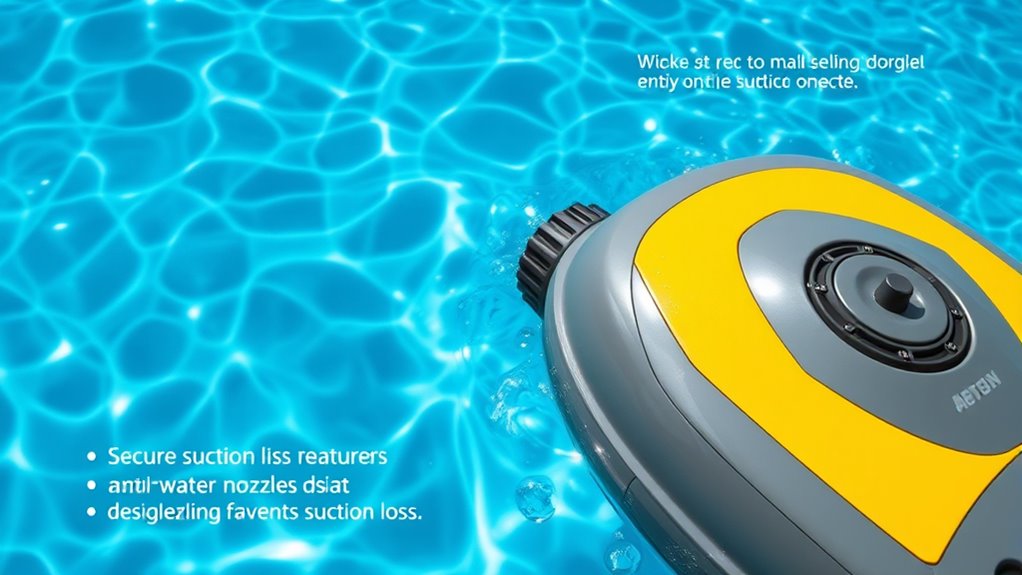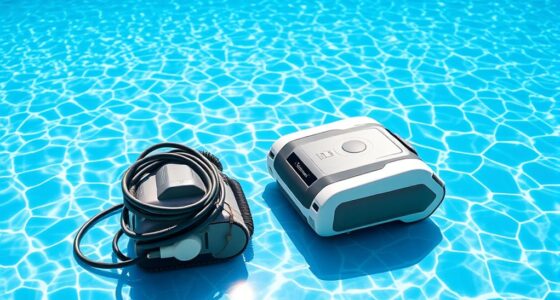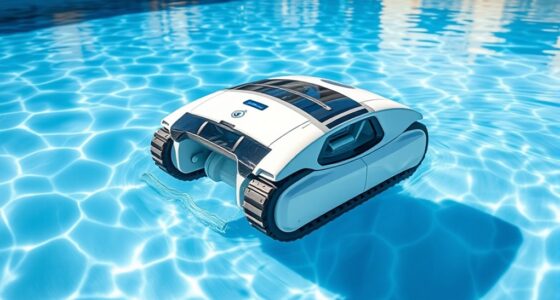To prevent suction loss in your pool cleaner, regularly inspect and clean hoses, pump baskets, and connections to avoid leaks and blockages. Make sure water levels are correct, and position the cleaner properly to maintain stable contact and flow. Remove debris from jets and filters to keep water moving smoothly. If issues persist, addressing problems early helps, but you’ll find more tips on preventing suction loss as you explore further.
Key Takeaways
- Regularly inspect and replace damaged hoses, connections, and seals to prevent leaks and maintain consistent suction.
- Maintain proper water levels and flow rates to ensure optimal skimmer function and prevent suction loss.
- Keep the pool cleaner properly positioned and free of obstacles for stable operation and continuous suction.
- Clear all system blockages, including hoses, skimmer baskets, and filters, to ensure unobstructed water flow.
- Conduct routine maintenance and seek professional help if suction issues persist despite basic troubleshooting.
Check and Clean the Skimmer and Pump Baskets Regularly

Regularly checking and cleaning your skimmer and pump baskets is essential to maintaining proper pool suction. Skimmer maintenance involves removing debris like leaves, dirt, and bugs that can clog the baskets. When these baskets are full, water flow slows down, putting extra strain on your pool pump and reducing the efficiency of your cleaner. To prevent this, inspect the baskets at least once a week and empty them as needed. During basket cleaning, rinse out any remaining debris and ensure the baskets are free of cracks or damage. This simple routine keeps water flowing smoothly, prevents blockages, and helps your pool cleaner operate effectively. Consistent basket cleaning is a quick, easy way to maintain ideal suction and extend your pool equipment’s lifespan. Additionally, using professional mechanic shops for regular inspections can help identify issues with your pool system before they cause significant problems. Ensuring the pump and skimmer system are well-maintained also supports optimal water circulation, which is vital for efficient cleaning. Regularly monitoring system performance can help detect early signs of trouble, preventing costly repairs later.
Inspect and Clear the Pool’s Return Jets and Inlet Valves

You should regularly check the return jets and inlet valves for blockages that can disrupt proper water flow. Make sure the seals are tight to prevent air leaks that could cause suction loss. Clearing obstructions and ensuring good seals keeps your pool cleaner working efficiently. Additionally, inspecting the website performance metrics can help identify recurring issues affecting your pool system.
Check for Blockages
Have you checked the pool’s return jets and inlet valves for blockages? Blockages can restrict water flow, causing suction loss. Start with a hose inspection to ensure hoses aren’t kinked or clogged. Remove any debris from the jets and valves to maintain proper suction. To help identify issues quickly, review this table:
| Issue | Cause | Solution |
|---|---|---|
| Reduced suction | Blocked return jets | Clear debris and check for clogs |
| Poor water flow | Inlet valves obstructed | Remove debris, inspect for damage |
| Hose blockage | Debris in hoses | Detach and flush hoses |
Regularly inspecting and clearing these components keeps your pool cleaner functioning smoothly and prevents suction loss. Additionally, proper maintenance of your pool equipment is essential for optimal performance. Maintaining pool system efficiency can also prevent common issues like suction loss and extend the lifespan of your equipment. Ensuring routine inspections can help catch potential problems early and keep your pool system running reliably. Regular cleaning and component checks are key to long-term pool health.
Ensure Proper Seals
Are the seals around your pool’s return jets and inlet valves intact and functioning properly? Conduct a thorough seal inspection to spot any cracks, tears, or signs of wear. Damaged seals can cause air leaks, leading to suction loss in your pool cleaner. If you notice compromised seals, gasket replacement is essential to restore a proper seal. Carefully remove the old gasket and install a new one designed for your pool’s system. Ensure all seals are snug and correctly positioned to prevent air from entering the system. Regularly checking and maintaining these seals helps maintain ideal suction and keeps your pool cleaner working efficiently. Proper sealing not only prevents suction loss but also extends the lifespan of your pool’s plumbing components. Additionally, understanding the importance of proper maintenance techniques can help you troubleshoot issues quickly and keep your pool system running smoothly. Incorporating preventive measures such as routine inspections can further improve the longevity of your pool equipment. Regularly inspecting pool plumbing components can help identify potential issues early before they lead to significant problems. Recognizing signs of air leaks early can save you time and repair costs, ensuring your pool stays in optimal condition. Implementing these practices aligns with the goal of maximizing system efficiency and maintaining a clean, functional pool environment.
Ensure Proper Positioning of the Pool Cleaner
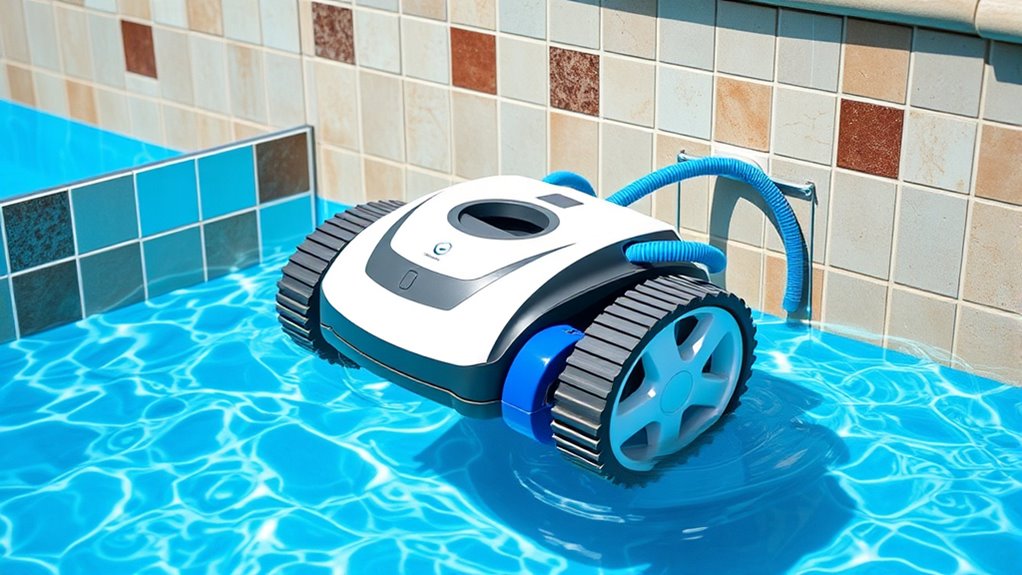
To keep your pool cleaner functioning properly, make sure it’s correctly aligned in the pool. You should also check that it stays stable and doesn’t shift out of position during operation. Proper placement helps maintain consistent suction and cleaning efficiency. Additionally, understanding aura management strategies can help optimize your equipment’s performance for better results. Implementing automation in pool maintenance, such as robotic cleaners, can further enhance efficiency and reduce manual effort. Regularly monitoring your cleaner’s proper positioning can prevent issues like suction loss and extend the lifespan of your equipment.
Correctly Align the Cleaner
Properly aligning your pool cleaner is essential for maintaining suction and ensuring effective cleaning. Misalignment can cause alignment issues that reduce performance and increase the risk of suction loss. To get the best results, follow these positioning tips: position the cleaner so it moves smoothly along the pool floor without obstructions, and ensure the brushes and wheels are aligned correctly with the targeted areas. Check that the intake and discharge ports are properly connected and free of debris. Adjust the cleaner’s orientation if it veers off course or gets stuck, as poor alignment can hinder its ability to pick up dirt efficiently. Taking these steps helps keep your cleaner properly aligned, maximizing suction and improving overall cleaning effectiveness. Additionally, understanding suction technology can help you troubleshoot issues more effectively and optimize your cleaner’s performance. Regularly inspecting and maintaining the alignment components ensures consistent suction and prolongs the lifespan of your pool cleaner. Proper pool water chemistry also contributes to the smooth operation of your cleaner by preventing buildup that can obstruct its movement, and using filter maintenance techniques can prevent clogging and maintain optimal suction levels. Regularly verifying the hose connection is secure can prevent air leaks that cause suction loss and disrupt cleaning.
Maintain Stable Placement
Maintaining stable placement of your pool cleaner prevents it from drifting or becoming stuck, which can disrupt suction and reduce cleaning efficiency. Different pool cleaner types, such as robotic, suction-side, or pressure-side models, require proper positioning to maximize suction power. Verify the cleaner stays in the desired area by adjusting its movement pattern or securing it with guiding devices if needed. Regularly check for obstacles or debris that could cause it to lose contact with the pool surface. Proper placement helps maintain consistent suction, preventing loss of power that can lead to incomplete cleaning. By keeping your cleaner stable, you enhance its efficiency and prolong its lifespan, making sure your pool stays clean with minimal effort.
Examine and Replace Damaged or Worn Hoses and Connections
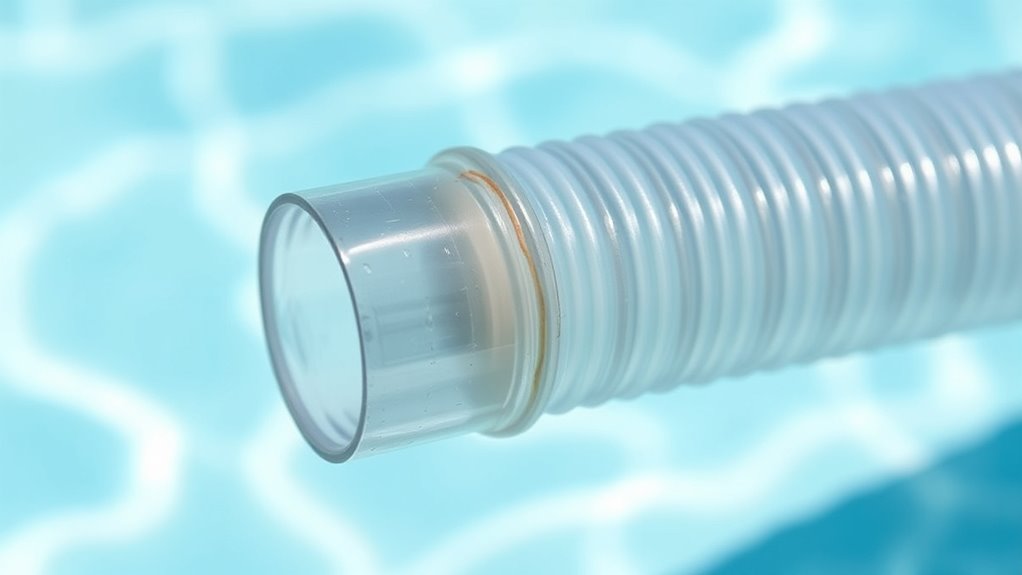
Inspecting the hoses and connections regularly is crucial because damage or wear can cause suction loss in your pool cleaner. During hose inspection, look for cracks, tears, or stiff spots that might hinder water flow. Check all connections to verify they’re secure and free of leaks. Worn or damaged hoses can reduce suction power, making your cleaner less effective. If you notice any cracks or signs of deterioration, it’s time for connection replacement to restore proper function. Replacing damaged hoses or loose connections is straightforward and prevents minor issues from escalating into major repairs. Keep a close eye on these components, especially after a heavy pool season or rough handling, so your pool cleaner maintains ideal suction and cleans effectively. Understanding how to troubleshoot common issues can also help maintain optimal performance. Regular maintenance of hoses and connections also aligns with air purifier maintenance dos and don’ts, ensuring your equipment functions efficiently and prolongs its lifespan. Additionally, consulting regional resources and tools can provide guidance on choosing the right replacement parts for your specific pool model.
Maintain Correct Water Levels in Your Pool

Ensuring your pool has the correct water level is essential for ideal cleaning performance. When the water is too low, the skimmer can’t operate properly, causing suction loss. Conversely, if the water is too high, your cleaner may not reach the pool floor effectively. Maintaining proper water levels keeps the skimmer functioning efficiently, guaranteeing consistent suction and cleaning power. Regularly check the water level and adjust as needed, especially after heavy rain or evaporation. This simple step prevents suction issues that could compromise your pool cleaner’s performance.
- Keep the water level at the mid-skimmer opening
- Regularly monitor water levels, especially during seasonal changes
- Ensure the skimmer operates freely without obstructions
Adjust the Pool Cleaner’s Flow Rate Settings
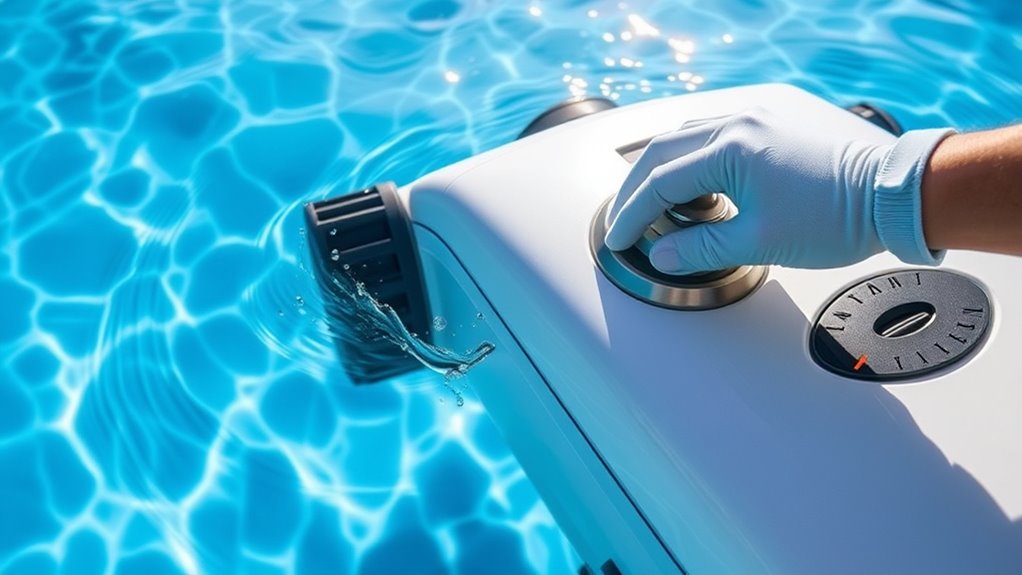
To keep your pool cleaner working effectively, it’s crucial to adjust the flow rate settings on your cleaner. Proper flow adjustment helps maintain ideal pressure regulation, preventing suction loss. Check your cleaner’s manual to find the recommended flow rate for your model. Use the control valve or settings on your pump or cleaner to increase or decrease water flow as needed. Too high a flow can cause excessive pressure, leading to suction loss, while too low can reduce cleaning efficiency. Adjust gradually, observing how the cleaner responds. Regular flow regulation ensures consistent suction and effective debris removal. By fine-tuning the flow rate, you minimize the chances of suction loss and keep your pool cleaner operating smoothly.
Remove Obstructions From the Pool’S Pump and Filter System
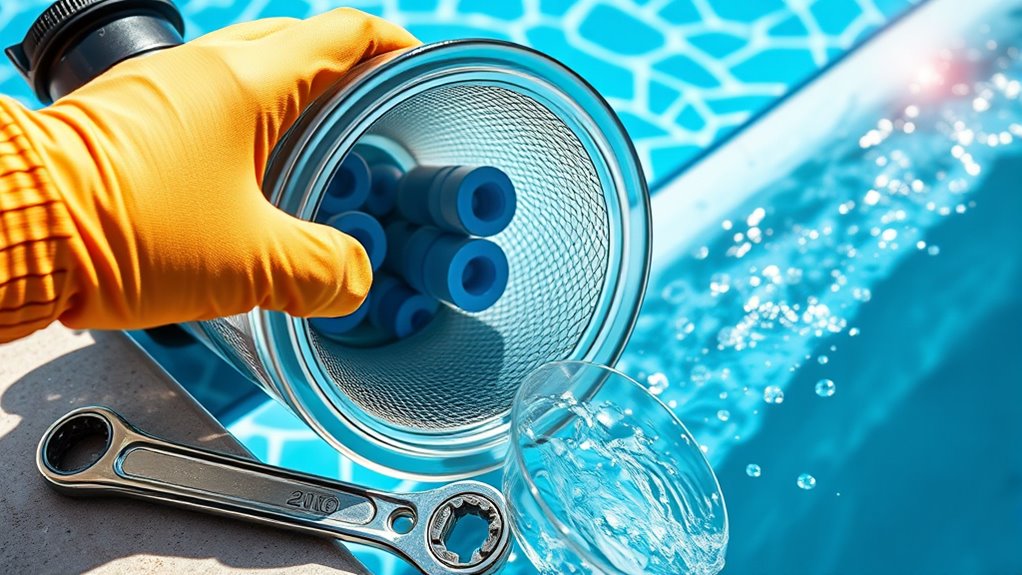
Start by checking for any blockages in your pump and filter system that could be restricting water flow. Make sure to perform regular maintenance to keep everything clean and functioning properly. Removing obstructions promptly helps maintain peak suction for your pool cleaner.
Check for Blockages
Blockages in your pool’s pump and filter system can substantially reduce suction, so it’s essential to check for obstructions regularly. Start with a thorough hose inspection to ensure no debris or kinks restrict water flow. Next, examine the filter for any filter blockage, which can hinder circulation and suction. Also, inspect the skimmer basket and pump strainer for debris buildup. Small obstructions can significantly impact your pool cleaner’s performance. Keep an eye out for:
- Debris in hoses or hoses with kinks
- Clogged or dirty filters
- Obstructions in the skimmer or pump strainer
Addressing these issues promptly restores proper suction and keeps your pool cleaner functioning efficiently. Regular checks prevent minor problems from turning into major issues that could impair your pool cleaning system.
Regular System Maintenance
Regular system maintenance is essential for preventing suction loss by ensuring your pool’s pump and filter remain free of obstructions. Regularly inspect and clean filters, remove debris, and check for blockages that could hinder water flow. Maintaining proper pool chemical balance also helps prevent algae and buildup that could clog components. Additionally, inspect pool lighting to ensure it’s functioning correctly, as faulty lights can sometimes interfere with system performance. Use the table below to visualize key maintenance tasks:
| Task | Frequency | Purpose |
|---|---|---|
| Clean filters | Weekly or as needed | Remove debris and prevent clogging |
| Check for obstructions | Monthly | Maintain ideal water flow |
| Test pool chemical balance | Weekly | Prevent buildup that impacts system efficiency |
| Inspect pool lighting | Monthly | Ensure proper operation and avoid interference |
Prime the Pool Cleaner Properly Before Use
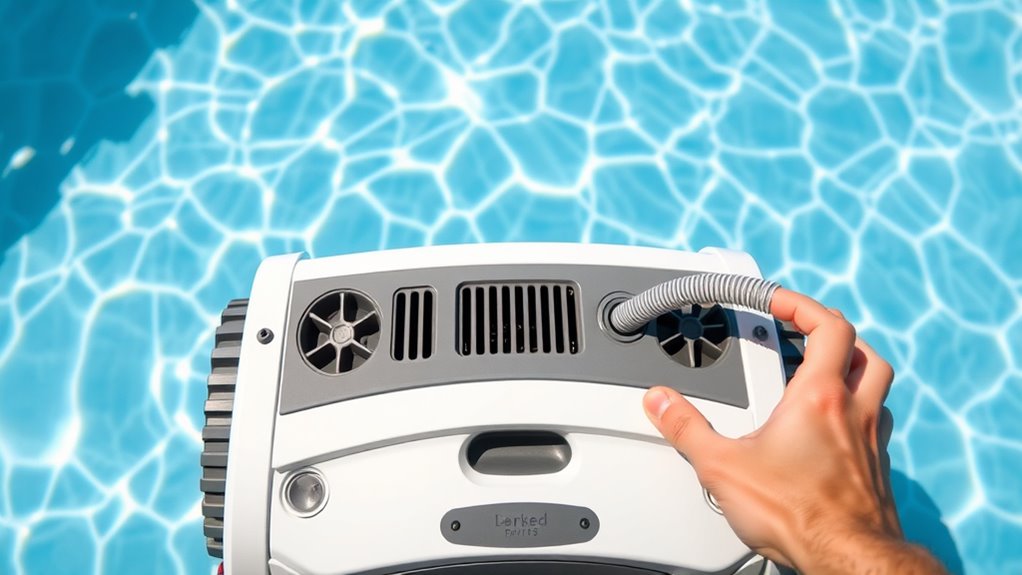
Before using your pool cleaner, it’s crucial to prime it properly to guarantee peak suction and cleaning performance. Whether you have a suction-side or pressure-side pool cleaner, ensuring the suction system is filled with water helps prevent air leaks that cause suction loss. Proper priming allows the cleaner to move effectively and cleans thoroughly.
To prime your pool cleaner:
- Submerge the cleaner and its hose completely before connecting it to the skimmer or suction port.
- Remove any air from the hose by filling it with water, then reconnect it securely.
- Turn on the pump to start the water flow, checking for steady suction without air pockets.
Taking these steps ensures your pool cleaner functions optimally, regardless of its type or suction system.
Regularly Service and Maintain Your Pool’s Pump and Filter System
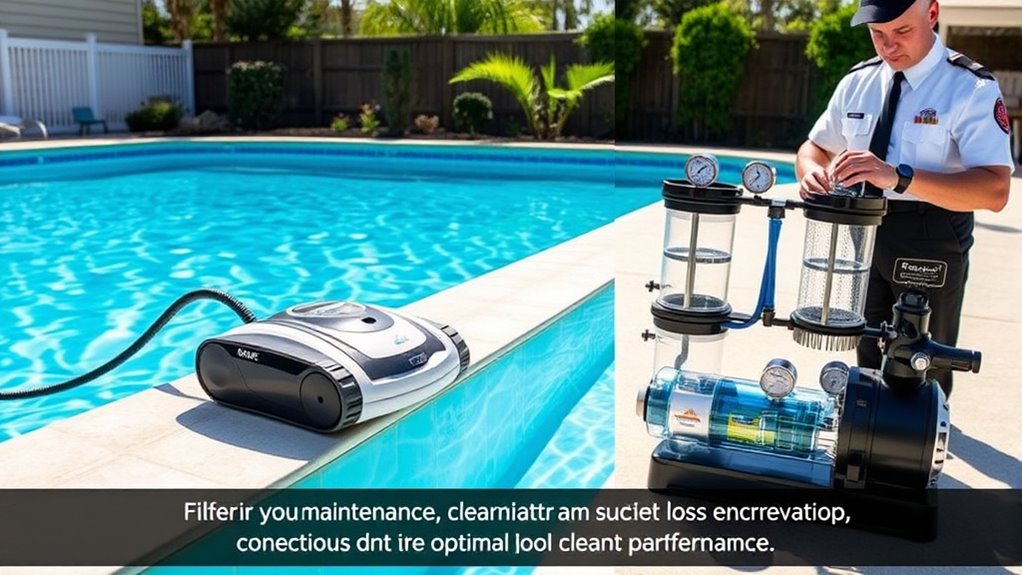
To keep your pool cleaner running smoothly, you need to service and maintain your pump and filter system regularly. Improving pump efficiency guarantees your cleaner gets consistent suction, preventing loss of power. Check for any signs of wear or damage, and clean the pump basket and impeller as needed. Regular filter cleaning is essential; a dirty filter restricts water flow, reducing suction and causing your cleaner to struggle. Backwash or replace the filter media according to your system’s schedule. Keep an eye on pressure gauges—high readings often indicate the need for cleaning. By maintaining your pump and filter system, you’ll guarantee optimal water flow, maximize suction, and keep your pool cleaner operating effectively without interruptions.
Troubleshoot Common Causes of Suction Loss and Seek Professional Help When Needed
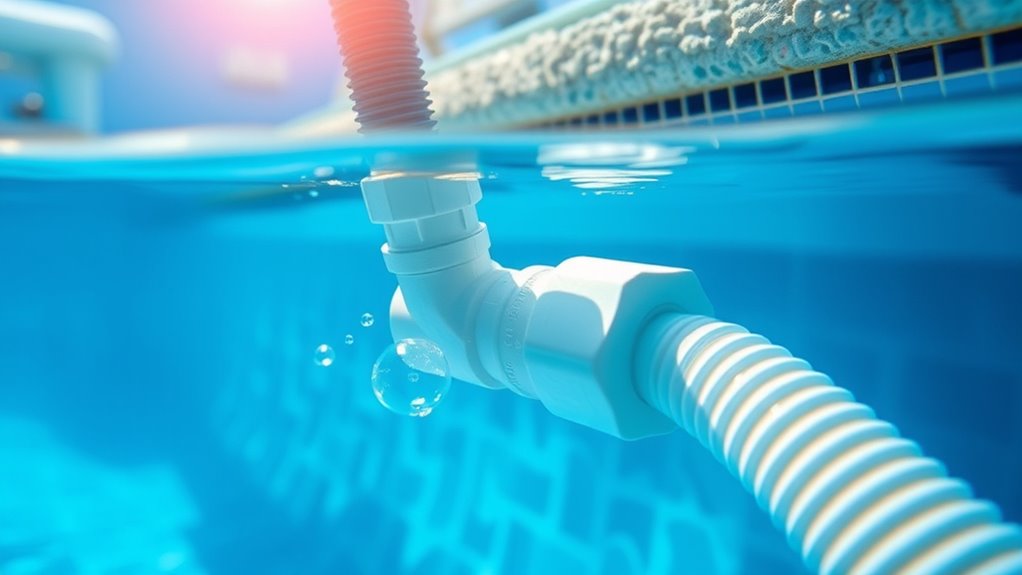
When your pool cleaner isn’t maintaining proper suction, pinpointing the cause quickly can save you time and frustration. Common issues include clogged hoses, dirty filters, or low water levels. Before calling a professional, check these potential problems:
- Inspect and clear any debris from hoses and connections.
- Ensure your pool’s chemical balancing is correct, as imbalances can affect suction and algae prevention.
- Verify that your pump and filter system are functioning properly and that water levels are adequate.
If these steps don’t resolve the issue, seek professional help. A technician can evaluate whether there’s a deeper problem with your pump, plumbing, or leaks. Addressing these issues promptly keeps your pool clean and maintains ideal suction for your cleaner.
Frequently Asked Questions
How Do I Identify if My Pool Cleaner Is Losing Suction?
You can tell if your pool cleaner is losing suction by checking the vacuum pressure; if it drops or the cleaner moves sluggishly, that’s a sign. Also, inspect the hose for leaks or cracks, as these can cause suction loss. Make certain all connections are tight and the skimmer basket isn’t clogged. These simple checks help you identify issues quickly so you can fix them and keep your cleaner working efficiently.
Can Algae Growth Affect the Suction of My Pool Cleaner?
Ever wondered if algae growth affects your pool cleaner’s suction? It definitely can. Algae buildup on the pool floor or walls can clog your pool filter and hinder water flow, reducing suction. A clogged filter or algae buildup creates resistance, making it harder for your cleaner to move effectively. Regularly cleaning the filter and brushing algae off surfaces keeps water flowing smoothly, ensuring your pool cleaner works efficiently.
What Are Signs of a Faulty Pool Cleaner’S Seals or Gaskets?
If your pool cleaner isn’t working properly, you might notice seal leaks or gasket deterioration. These issues cause water to escape, reducing suction power. Signs include air bubbles around the cleaner, difficulty in picking up debris, or the cleaner drifting unevenly. Regularly inspect the seals and gaskets for cracks or wear, and replace them promptly to keep your cleaner functioning efficiently and prevent further damage.
Is There a Recommended Frequency for Replacing Pool Hoses?
When it comes to hose replacement, sticking to a regular maintenance schedule keeps your pool cleaner running smoothly. Experts recommend checking your hoses every 3 to 6 months, inspecting for cracks, leaks, or wear, and replacing them as needed. This proactive approach prevents clogs, maintains suction, and extends the life of your equipment. Consistent hose replacement ensures peak performance, saves you money, and keeps your pool sparkling clean.
How Can Temperature Fluctuations Impact Suction Performance?
Temperature fluctuations can impact your pool cleaner’s suction performance through thermal expansion, causing hoses and fittings to loosen or crack. To minimize this, you should use insulation techniques around hoses and connections, which help stabilize temperature changes. Regularly check for leaks or loose fittings, especially during seasonal shifts. Proper insulation and maintenance ensure your cleaner maintains peak suction, even when outdoor temperatures vary considerably.
Conclusion
By staying vigilant and maintaining your pool’s essentials, you keep the flow smooth—like a well-oiled machine. Think of it as tending your own oasis, where every part works in harmony. With regular checks and quick fixes, you’ll prevent suction loss and keep your pool pristine. Remember, a little effort now saves you from bigger problems later—so stay attentive, and your pool will reward you with endless, crystal-clear enjoyment.
